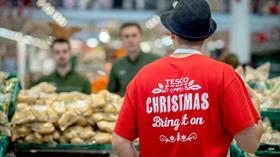
Take-home grocery sales reached £31.7 billion in the 12 weeks to 26 December 2021 as shoppers made the most of Christmas festivities, according to the latest figures from Kantar.
Although down by three per cent compared with 2020, spending remains higher than it was before the pandemic and sales were eight per cent stronger than in 2019.
Premium own-label sales broke records this Christmas and shoppers spent £627 million on supermarkets’ own upmarket lines over the four weeks to 26 December, an increase of 6.8 per cent versus 2020.
“The appetite to celebrate and splash out that little bit more this year pushed sales of luxury own-brand products up across the board,” said McKevitt.
Tesco’sFinestand Sainsbury’sTaste the Differenceare by far the largest premium own-label ranges, but other ranges such as AsdaExtra Specialand IcelandLuxuryenjoyed the fastest growth.
While spending on many traditional Christmas dinner items was broadly similar compared with last year, there was evidence of people treating themselves and guests.
Sales of mince pies reached £62m in December, up seven per cent on 2020, while chocolate sales rose 21 per cent to £61m.
Plant-based rise
Unfortunately, sprout sales dipped by three per cent on 2020, but half of UK households still bought the traditional Christmas brassica in December.
Meanwhile, new dietary trends came through in the data and plant-based foods proved particularly popular. Sales of chilled vegetarian ranges were up six per cent while their frozen equivalents rose by four per cent compared to the same period in 2020.
Fraser McKevitt, head of retail and consumer insight at Kantar, said:“People seized the chance to enjoy Christmas with friends and family after last year’s muted festivities, and grocery sales hit £11.7 billion over the month of December alone.
“This lofty spend figure is down just 0.2 per cent on record 2020 sales when several areas faced restrictions and the data suggests that while there weren’t formal rules in place across the UK this year, many people celebrated at home again due to Omicron.
“We can really see just how much spending accelerated in December compared with earlier in the year by looking at the average trend during March to November when sales were down by 2.5 per cent against 2020.'
Prices shoot up
Alongside Christmas indulgence, rising prices also pushed up shopping budgets, with groceryprice inflation reaching 3.5 per cent in December. This added nearly £15 to shoppers’ average monthly grocery bill.
“We saw prices rise faster for a short while in Spring 2020 when promotions were cut to maintain product availability, but before that you would have to go back nearly four years to January 2018 to see inflation running higher,” noted McKevitt.
In-store success
As is traditional, the busiest shopping day of the year was 23 December but thereal driver of bumper sales was in store rather than online, with December seeing the largest number of store visits since March 2020.
Despite rising Covid-19 case numbers, online sales fell in December by 3.7 per cent year on year, accounting for 12.2 per cent of sales.
Individual retailers found it challenging to secure year-on-year growth over the Christmas period following last year’s highs, but every major grocer increased sales compared with the final 12 weeks of 2019.
Online specialist Ocado was the only retailer to buck the trend over the latest 12 weeks and grow versus 2020, increasing its sales by 2.5 per cent.
Tesco on the march
At the same time, Tesco continued to gain market share, up by 0.6 per cent to 27.9 per cent, the highest it’s been since January 2018.
Aldi, Lidl and Waitrose also grew their shares by 0.3 per cent, 0.2 per cent and 0.1 per cent respectively.
Second-largest grocer Sainsbury’s now holds 15.7 per cent of the market, with Asda on 14.2 per cent and Morrisons on 10.1 per cent.
Independent retailers have a combined share of 1.6 per cent. Meanwhile, 5.8 per cent of the market belongs to the Co-op and 2.4 per cent to Iceland.



